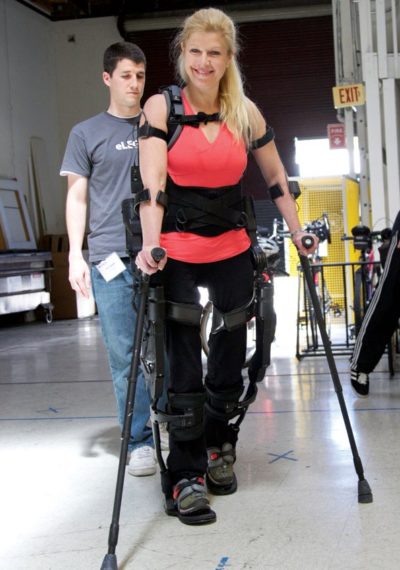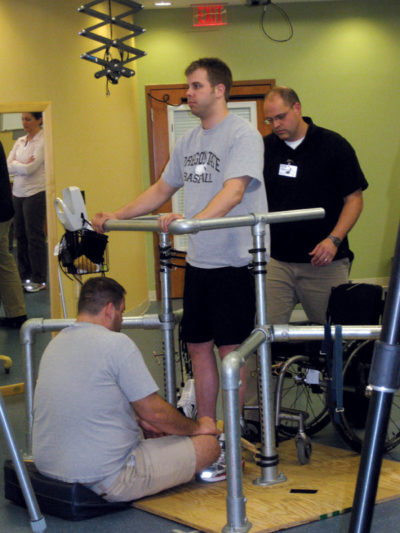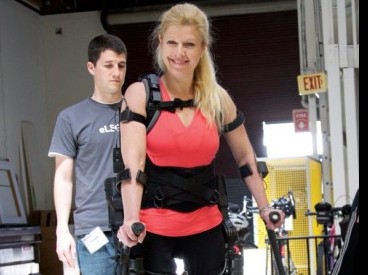
On February 27, 1992, 24-year-old Amanda Boxtel took a freak somersault on a downhill ski slope—and as she did, life as she knew it went somersaulting out of her control. A jolt of electric current passed through her legs, and then she realized she could no longer feel them at all. At the hospital her fears were confirmed. She had four shattered vertebrae and a bruised spinal cord and she was paralyzed from the hips down. She assumed she’d be confined to a wheelchair for the rest of her life.
For many years Boxtel, now 44 and living in Basalt, a quaint mountain community near Aspen, Colorado, worked to make the best of her wheelchair-bound existence. She learned to ski again, this time sitting down, and became a ski instructor for people with disabilities. She helped start an organization called Challenge Aspen, which helps disabled athletes participate in sports despite their physical limitations. But she kept hoping, against all odds, that she would walk again.
In July 2010 Boxtel got a phone call from a man who introduced himself as Eythor Bender. He was the CEO of a start-up company called Ekso Bionics, and he explained that his company was developing a metal exoskeleton designed to allow wheelchair users to stand and walk on their own. The device contained four motors and more than a dozen sensors that replicated a natural human gait, and it was particularly well-suited to people with lower limb paralysis. After hearing about Boxtel’s work as a speaker and wheelchair athlete, Bender had decided that he wanted her to be one of the first to test his exoskeleton.
Boxtel took Bender up on his offer, and a week later she was on her way to Ekso headquarters to try out the device. She squared the battery backpack on her shoulders and had the black brace supports strapped onto her legs; what happened next surpassed her wildest expectations. “I stood up like a normal person for the first time in 18 years. Then I took my first steps. I walked with a bent knee, step after step. I felt as if I had springs in my ankles,” remembers Boxtel, who now works for Ekso and demonstrates the exoskeleton to potential users. “I went home and I just cried because it was overwhelming. It was what I had dreamed about.”
Poised to become available for home use by late 2013, the robotic exoskeleton should help thousands of people like Boxtel take their first post-injury steps. But the device isn’t an island unto itself; it’s part of a fast-growing landscape of innovations that promise to make life easier and more fulfilling for paralyzed patients. Not content to simply work around the problem with assistive devices such as exoskeletons, researchers are hot on the trail of actually treating paralysis using brain-machine interface devices. These tools would be able to read brain waves and turn them into controllable arm or leg motions—in effect, translating intent directly into movement. Implantable electrodes would activate muscles when neural connections between limbs and the spinal cord have been severed. Such treatments are not yet within reach, but for the 5.6 million Americans living with paralysis—including 1.3 million with spinal cord injuries—any steps scientists make toward restoring freedom of movement are milestones to be celebrated.
At neuroscientist Chet Moritz’s lab in the University of Washington’s Center for Sensorimotor Neural Engineering, the quest to restore missing connections between the brain and body is underway in a room the size of a walk-in closet bathed entirely in red light. Lining the walls are several rows of clear cages containing rats that have incomplete spinal cord injuries, the most common type seen in human patients. Each animal is wearing a lozenge-sized beanie, a connector attached to electrodes implanted in the brain or spinal cord. Some of these electrodes record signals from the rats’ brains, Moritz explains, and other electrodes run under the skin to enter a part of the spinal cord that controls movement of the upper limbs.

Moritz’s ultimate goal is to develop a system that will pick up electrical impulses that arise in the brain when a paralyzed person thinks about performing a movement, route them through a small computer, and send electrical stimulation to the body to generate the movement itself. Scientists working on these so-called brain-machine interfaces have demonstrated that brain activity can be harnessed to control computer cursors or robotic arms, and Moritz and other researchers have recently used brain impulses to control artificial stimulation of paralyzed muscles in the arms or legs. One problem with stimulating muscles directly, however, is that movements initiated this way tend to be jerky because artificial electrical stimulation activates the muscles more quickly and abruptly than the brain naturally would. “If you’re trying to pick up a flexible cup, you might crush it,” Moritz says.
To circumvent this issue Moritz and his colleagues are experimenting with sending electrical signals directly to the spinal cord instead of the muscles. His work and that of other scientists demonstrates that when a spinal cord is stimulated electrically, it sends instructions to the limbs to perform complex acts like reaching or grabbing. Although connections between the brain and the spinal cord are damaged after injury, Moritz thinks this technique may help restore some hand and arm function.
His experiments have begun to support this theory: Partially paralyzed rats whose spinal cords are being stimulated are better at grabbing food pellets with their impaired limbs than rats that are not receiving the stimulation. I watch, transfixed, as a lab-coated technician lifts a food pellet with tweezers and places it in front of one of the beanie-clad rats. Although the pellet is on the other side of a small opening in a clear glass panel, the rat easily reaches through to grab it.
Moritz’s team has already demonstrated that by electrically stimulating a single site in an uninjured monkey’s spinal cord, he can coax the monkey to make a pinch-grip movement. He hopes activity from humans’ brains can be sent via a small computer to trigger electrical stimulation of the spinal cord so that paralyzed people will someday be able to grab a cup or turn a doorknob effortlessly. “The goal is to take brain activation and relay it to the spinal cord below the injury.”
Other scientists around the country, including electrical engineer Euisik Yoon at the University of Michigan, are also working on promising brain-machine interface devices. Yoon’s BioBolt, about the size of a penny, sits on top of the brain and contains microcircuits that record neuronal activity and transmit it wirelessly to an external computer. Such a computer could then send out electrical signals to reactivate paralyzed limbs—or potentially to do things like display words on a computer screen for patients whose paralysis impairs their ability to speak. “Brain-machine interfaces have the potential to restore communication, movement, and sensation,” Moritz says. “For paralyzed individuals, this could allow them to once again interact with their outside world.”
Hundreds of miles away at the California Institute of Technology, mechanical engineer Joel Burdick shares Moritz’s belief that sending electrical stimulation to selected sites on the spinal cord may be the ideal way to help paralyzed patients make controlled limb movements. After a spinal cord injury, Burdick says, the connection between the spinal cord and the brain may be severed, but “the [spinal cord] circuitry’s all down there, and it doesn’t degenerate.”
Although Moritz’s work is still largely in the theoretical stages, Burdick and his collaborators V. Reggie Edgerton, Yury Gerasimenko, and Susan Harkema have gotten government approval to test their theories on a small group of paralyzed human patients. Burdick’s system bypasses the complications of implanting electrodes in the brain by stimulating the spinal cord directly, reawakening connections between the spinal cord and the lower limbs. When you walk, Burdick explains, there’s a special circuitry in your lower spinal cord that helps to control your strides, and his electrical-stimulation system takes advantage of this natural circuitry. To install the system the team implants an array of electrodes next to the dura, the thick protective sheath that surrounds the spinal cord. “We pop off half of a vertebra and insert the electrodes. Then the neurosurgeons put sutures in place and we close everything up,” Burdick says.
After the electrodes—16 of them, each in a different location—are placed, a computer can send currents through the attached wires to the spinal cord, adjusting the voltage or the frequency of the electrical stimulation to restore the missing signals that move the legs. “We get the circuits down there excited again,” Burdick says. “What happens is [the circuits] get the input and they already know how to compute the muscle movements, so they apply those movements.” This shortcut approach works because certain basic movements such as stepping are controlled primarily by the spinal cord not the brain.
The first patient to test Burdick’s system was Rob Summers, a 20-something former pitcher for Oregon State’s baseball team who was paralyzed from the chest down in a 2006 hit-and-run accident. Near the end of 2009 surgeons implanted electrodes into Summers’ spinal cord, which are attached to a wire that runs down to a device on his hip containing the electrical stimulation hardware. After weeks of intensive physical training, Summers is now able to stay standing for about 20 minutes at a time and can make stepping movements on a treadmill while his spinal cord is being stimulated. (He still can’t make voluntary movements after the stimulation stops.)

The first time Summers was able to wiggle his toes, Burdick remembers, was a red-letter day. Summers was joking around with Claudia Angeli, one of his doctors, during a procedure where she was measuring his muscle activity with sensors. “He said, ‘Let me see if I can move my toe,’ and he did. She just about dropped on the floor.”
But Burdick and his colleagues see Summers’ remarkable improvements as just a preliminary step. Burdick describes his current system as a “crude hammer” because the electrodes excite whole groups of spinal cord neurons at a time. The team plans to take a more targeted approach in the future, stimulating neurons more precisely to produce more distinct kinds of movement. In addition, Burdick thinks spinal cord stimulation may prove a key adjunct to biological therapies still in the works such as stem cell infusions and tissue transplants. Even if these approaches come to fruition, he says, “it’s naïve to think people are going to get up and walk away. You’re going to have to retrain the spinal cord anyway.”
Before invasive technologies such as brain-machine interfaces and customized spinal cord stimulation arrays can become widely available, however, they will have to prove their mettle in long-term clinical trials involving large numbers of patients—trials that will likely cost millions of dollars. So, although these targeted-stimulation systems offer perhaps the best hope for paralyzed people to regain their former mobility, potential users may have to wait years—possibly decades—to reap their benefits.
The advantage of an exoskeleton, by contrast, is that it’s nearly ready for widespread rollout. Ekso plans to complete trials at rehabilitation centers nationwide and have the device ready for home use by the end of 2013. Even though the exoskeleton doesn’t allow paralyzed patients to move their limbs with the same degree of fine motor control brain-machine interfaces aim to provide, it does give them freedom of movement most haven’t enjoyed since their pre-injury days. In a round of testing last fall at the Kessler Institute in West Orange, New Jersey, six patients with spinal cord injuries of varying severity were able to use the device to walk using walkers or canes to stay balanced.
One tester, Mike Rhode, had resigned himself to life in a wheelchair after a 2010 skiing accident left him with paralyzed arms and legs, but Kessler staff told him the exoskeleton might let him stand up and move on his own. “They said, ‘You’re going to lean forward like you’re getting up out of a chair, and the unit will assist you in standing up,’” he says, recalling the first day he got to use the device. “One, two, three—I pushed up. It was an unbelievable feeling. After I was up walking for an hour, I had this euphoric tingling feeling in my body for a few days.”
Boxtel, too, says the exoskeleton’s benefits go beyond helping her get from one place to another. When she’s in a standing position, she says, “I’m no longer prone to edema—my ankles are no longer cankles—and my bladder works more efficiently.” And although the device might seem a little clunky at first, Boxtel says the exoskeleton feels natural now; she thinks it’s the next best thing to being restored to a physically able state. “The robot encases my frame like an outer shell. The metal is like my bone structure, and the motor is like my muscles.” While scientists continue to work at reviving dormant connections between the brain, spinal cord, and muscles, this bionic pinch-hitter is allowing paralyzed people to take huge steps forward.
Become a Saturday Evening Post member and enjoy unlimited access. Subscribe now




Comments
Greetings from Cincinnati, Ohio!
I am a stroke victim: Spinal Cord Infarction at T-12/L-1 Incomplete (2006). I would love to be a ginea pig for your product here in the states. Would that be possible?
Let me know please!
Jim
Truly marvelous!! Will there be help for us stroke victims? with some brain damage?